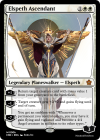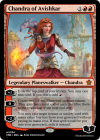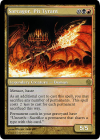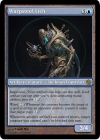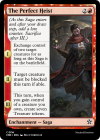https://cubecobra.com/cube/overview/END
psst hey kid wanna try some custom magic cards?
The End is a standalone draft-only spell-singleton* limited environment aimed to answer the question, “How could draft Magic be better if we didn’t have to design cards that would be played in constructed formats?” but I'll admit that's a little abstract. To put it a little more concretely, if you don't giggle with illicit glee after cracking a pack that looks like this, I guarantee you your money back:
Do you want to draft these cards? I know I sure do.
The cube is designed to have the aesthetics of Foundations with the excitement of a Horizons set, and is guaranteed to be 80%+ custom Magic cards, ranging from tweaks to existing favorites that are a little outside of my power band, to token realignments, to outright novel designs.
Please feel free to give me feedback on individual cards--the more advice the merrier!
Fun features include:
--Land vouchers! Exchange these cards for fixing lands after the draft!
--Thrilling designs! These would snap Legacy in half! But they're fine here!
--All of my favorite planes! They’re probably ones you like too!
--No Universes Beyond! Everything fits into the same world, more or less!
*(i.e. fixing lands are duplicated to some degree, but there are no duplicate spells or lands with spell-like effects)
Table of Contents:
Introduction
Quick Draft Tips
Archetypes
Mechanics (from a player's perspective)
My Motivations and Goals
Pillars of Design for Individual Cards (Probably the most interesting part for us custom design sickos)
Why Customs?
Self-Imposed Limitations (Overall cube design notes)
Mechanics (from a designer's perspective)
Tokens
Planes
Art, Permissions, and an Expression of Gratitude
Quick Draft Tips
Archetypes are a suggestion, not a demand--there are plenty of Jeskai decks that won't be based around the Flurry mechanic--but if you're looking for guidance about what to expect during your first or second draft, they're good starting points!
Also, the fixing lands are good.
Archetypes
Jeskai Flurry: Jeskai know better than anyone else that there’s as much a time for stillness as there is a time for blistering action. Orchestrate your turns with plenty of cheap spells and cantrips to keep your opponent on the back foot.
Mardu Unearth: Keep the pressure on with creatures that just won’t stay dead. Whether through dedication, unspeakable sacrifice, or pure excitement, your creatures will get the last laugh—not to mention the final blow. See if you can figure out ways around their inevitable demise for even more staying power.
Sultai Proliferate: Do you have any idea how many different types of counters are in this set? You’ll find out once you start looking to proliferate them. These decks tend to be slower, but once they grow past a certain point, they’re unstoppable.
Temur Landfall: People don’t appreciate nature anymore. Your opponents sure won’t when you’re playing a Landfall deck. They might even groan when you topdeck a land on your eighth turn! Come up with clever ways to pull lands from many different zones in this fetchless twist on Landfall.
Abzan Counters: You know them, you love them, it’s Abzan Counters. Outgrow and outlast your enemies by nurturing your creatures’ strength. Just make sure to have a plan for opponents packing removal spells.
Bant Harmony: A new mechanic, Harmony rewards you for having four or more types of permanent on the battlefield. Bant decks can expect a massive power spike when their Harmony cards come online, so draft plenty of artifacts and enchantments!
Esper Blink: Another classic, Blink strategies reward you for the things that already reward you—pretty tempting, right? Think couponing, just in Ravnica instead of Kroger. These strategies typically benefit from crafting a toolbox of abilities stapled to creatures.
Grixis Madness: In general, Grixis decks are very comfortable with symmetrical resource denial. Madness cards are one great way to break parity, although many more exist. Paradoxically, while it’s tempting to load up on anything that says Madness, a powerful Madness deck will have a well-considered balance between enablers and payoffs.
Jund Delirium: Delirium, while often easier to achieve than Harmony due to instants and sorceries dropping into the graveyard as soon as their cast, can be a little more fragile when your opponent is packing targeted hate cards. So take advantage of how fast this archetype can go to eliminate them while they’re distracted!
Naya Valiant: Play creatures. Turn them sideways. Cast spells or activate abilities that target them. Fun and profit. Not much else to say, apart from being creative with what counts as targeting.
Mechanics (from a player's perspective)
As I mentioned briefly, the ten archetypes presented above are neither meant to be prescriptive nor comprehensive. For example, Mardu Unearth might work best as described within WR, but WB might play closer to a traditional Aristocrats deck. Also, there are other strategies outside those listed—Flashback is a great way to trigger Flurry abilities, so self-mill might be especially important to some Jeskai decks.
There are many such mechanics that show up throughout the set without being explicitly tied to major themes. By limiting my design space to a moderate number of flagship mechanics, I hope to keep my cube thematically cohesive (and also to keep my job as a designer manageable!). Additionally, the relative familiarity of these mechanics is intended to ease the transition into an environment with so many entirely-novel cards.
Major themes:
Blink
Counters
Delirium
Flurry
Harmony
Landfall
Madness
Proliferate
Unearth
Valiant
Featured non-theme mechanics:
Adventure
Convoke
Delve
Explore
Flashback
Kicker
Multikicker
Ninjutsu
Raid
Reconfigure
Retrace
Sagas
Storm (but just a little)
Tokens (Blood, Clues, and Treasure)
My Motivations and Goals
I've talked a bit on this forum about how I got into cubing, but the gist of it is that I hated Masters 25. I thought it was a cop-out, a pale shadow of what it should have been. I felt robbed. This was supposed to be a celebration of Magic and all of its quirky charm, not a collection of boxes to be checked.
So I built it myself. I'll share that spreadsheet eventually, but I set myself the same set of limitations: at least one card from every set up until that point, draft archetypes, color balance, respecting the Reserved List, and minimal rarity shifting, while tacitly acknowledging the price of each of these cards. And you know what? I think I did a better job than they did. This cube is an extension of that dissatisfaction.
Pillars of Design for Individual Cards
In designing these cards, my watchwords have been verisimilitude and parsimony. Verisimilitude, as applied here, is characterized by printing cards that WotC could have plausibly printed. There are a couple of notable exceptions (Sphinx of Black Quartz being the most egregious by far), but I don't want to introduce massively new ideas within a text box. Similarly, I want the art to reflect what could plausibly be Magic characters in what could plausibly be a Magic setting.
I do deviate in a couple of notable ways. Specifically,
--I will deviate from official wording templates when it's both innocuous and particularly expedient to do so ("up to three target creatures" vs. the traditional "one, two, or three target creatures" saves seven characters, for instance).
--I will deviate from official standard set formats of power distribution. I would rather have more power at lower rarities than would otherwise be acceptable. These rarities are mostly just formalities, to be frank--it's a mostly-singleton cube, after all!--but the cards would feel naked without a rarity symbol. Plus, it helps me think of each color's balance of staple effects and flashy buildarounds--and once again provides me a subtle way to communicate this to drafters.
Parsimony takes two forms for me:
--A card should do one thing and one thing only
--A card should use as few words as possible
These rules get broken a fair bit in service of individual cards, but as general principles they've served me well. If an idea begins to stretch the text box, it's better to make a second card than to try to overstuff one.
Why Customs?
I'll go into this a little more in the next section, but I haven't found new Magic cards speaking to me in 2024 and 2025. I suppose this means I'm a boomer.
However, I firmly believe that if I don't like something, my reaction should be to work to improve it, rather than just complain about it. This is easy enough to do with Magic cards, which are really just words, and soon enough I had three or four dozen designs. One thing led to another, and I finally challenged myself to make a full cube out of them.
That said, there are some designs I kept coming back to. Burst Lightning. Abundant Harvest. Thraben Inspector. Plumecreed Escort. Bone Shards. I disagree with a lot of things the WotC team does, but when they get it right, they really hit the nail on the head. I want to keep these cards to less than 20% of my design file, which is an arbitrary number, but I feel it'll help strike a nice balance when opening packs--some friendly faces to help people find their way in an otherwise entirely novel world.
A major caveat is that these customs are all works in progress. I've borrowed a couple from some of my favorite designers (thanks Chris Taylor and Safra!), but apart from that I don't have anyone else helping me iterate on these designs. Something will inevitably slip through the cracks, power-wise. To a certain extent, that's fine (something has to be the strongest card in the cube), but I'd like to keep an eye on things that are too many standard deviations away from the median power level. Similarly, I don't want my cards to fall flat--one major pull towards a largely-custom set is that I can make cards that would be incredibly broken if they were unleashed upon a Standard set. Players should feel like they're getting away with something.
Self-Imposed Limitations (Overall cube design notes)
Mechanics (from a designer's perspective)
I've talked about how I'm limiting myself to twenty-five-ish mechanics. Personally, these are the ones that I'd consider the greatest of all time (with the notable exception of Retrace, but it fits really well and I had enough compelling designs that it slipped through the cracks). I'm motivated here by spite; I think that WotC does a really miserable job of reusing their mechanics. For example, Adapt isn't the best mechanic, but why didn't it show up in Duskmourne as the W/G mechanic instead of Survivor? Also, why not use Reconfigure in Edge of Eternities? There are compelling reasons to make new mechanics (one of them being that the people who make these sets need to justify their continued employment, a reason I'm highly sympathetic towards), but there are also a ton of compelling reasons to reuse and update old ones. I'm pleased as punch to see the pendulum swinging back towards reincorporating this things (such as the newfound enthusiasm for putting a couple of guest mechanics in every set) and slapping a new coat of paint on things like the Void spells in EOE being a re-imagining of Revolt, but I don't think that WotC does enough. Therefore, it's my job to make these cards.
I gave myself a couple of parameters for each mechanic. I don't want one-offs, or even two-offs--each mechanic has to appear on no fewer than four cards (except Storm, which is flavorful and historic but not fun to balance). I do this because while I try to keep my cards relatively comprehensible, the fact of the matter is that a fully custom draft is going to be exhausting for players in a way they've not experienced since their first few days of Magic. Consider: when's the last time you've played with cards that you've literally never seen before? Some people go into draft blind, but that's getting to be more and more of a rarity these days. Given the cognitive overhead required to parse individual cards, I decided to cut back on the crunch power needed to analyze single cards, and repeating mechanics is an easy way to do that.
Plus, limiting the list means that I can fit the full reminder text on a single sheet (and I can put the reminder text on most cards!).
Tokens
Similarly, I’m limiting myself to a handful of creature tokens. Many of the cards in this set are very slight tweaks on existing cards, but a large fraction of those are what I think of as “token alignments,” because I don’t want to have a bunch of different mechanically identical token at the same power/toughness split. This is still more tokens than I’d strictly like to see, but it feels appropriate for a Horizons/Masters-level set with Foundations-like constraints. (Un-fun fact: did you know that Foundations included thirty-one different tokens outside of emblems?? That’s bananas! And Core Set 2021, the last Core Set proper, had fifteen to seventeen such, depending on if you count the tokens from Rin and Seri! This makes me feel alright about my personal cap, which I’ve decided is somewhere between fifteen and seventeen, inclusive.)
Tokens include:
1/1 white Human Soldier
1/1 white Spirit with flying
2/2 white Knight with vigilance
4/4 white Angel with flying and vigilance
2/2 black Zombie with decayed
1/1 red Goblin
1/1 red Elemental with haste until end of turn
5/5 red Dragon with flying
2/2 green Wolf
5/5 green Wurm
1/1 artifact creature Servo
Blood
Clue
Food
Treasure
Decayed Zombies are cool! WotC should come back to that mechanic!
Planes
My final logistical goal is to include the planes I like the most. The reasons are varied, ranging from the curmudgeonly hatred of Universes Beyond to a love for the Redwall books, but I want to have at least a couple cards from each of the following:
Alara
Amonkhet
Avishkar (née Kaladesh)
Bloomburrow
Dominaria
Eldraine
Fiora
Innistad
Ixalan
Kamigawa
Lorwyn
Ravnica
Tarkir
There are many more great worlds, and I’m looking forward to falling in love with others, new and returning. But for now, I’m hoping to create a cohesive Foundations-like experience by focusing on this set of planes. If you think that one of these is undersupported and you have the time to give feedback, I'd love to hear suggestions about what I might reflavor to rectify that issue!
Art, Permissions, and an Expression of Gratitude:
I got the art for all these cards from the internet, as anyone does in the 21st century. These are all pieces that I think are impressive, beautiful, or otherwise worthy of consideration, but they're by no means mine. Thank you to all these artists—and all artists—who share their work with the public in any way, shape, or form. I did my best to make sure that the artists of these pieces are generally okay with personal use of their art, but I'm human and can make mistakes. Therefore, if you are the artist who made these, or are the representative thereof, and you don't want me using your art for any reason at all, I'd be more than happy to remove it. Please just let me know! My one caveat is that this is a single-person, not-for-gain fan project, so my response time might be slightly slower than you might expect, especially if you get here several years after I write this.
Similarly, if I have attributed any of the art incorrectly, please let me know. These people have put in a ton of time and effort, and deserved to be recognized for it.
Conversely, if you are interested in using any of these designs--go for it! I made these things for free and would be flattered to see them used elsewhere. No need to check, but I'll happily send over the MSE file if you need it.
And speaking of which, I made some higher-resolution templates that should print a little nicer than the stock MSE ones. I'm happy to forward those to any with interest.
Huge thanks to @Chris Taylor @safra @anotak @Onderzeeboot @TrainmasterGT @Mown and Lady Lynn (forgot your handle here) for early feedback on the Discord and helping me dial in on what I wanted this cube to be!
...and yes, I know that I owe you all photographic evidence of Siege Rhino cookies. I swear a solemn oath that will deliver those photos to this forum by July 20th, 2025, midnight GMT, or forfeit my right to defend myself against mockery.
psst hey kid wanna try some custom magic cards?
The End is a standalone draft-only spell-singleton* limited environment aimed to answer the question, “How could draft Magic be better if we didn’t have to design cards that would be played in constructed formats?” but I'll admit that's a little abstract. To put it a little more concretely, if you don't giggle with illicit glee after cracking a pack that looks like this, I guarantee you your money back:

|

|

|

|

|

|

|

|

|

|

|

|
Do you want to draft these cards? I know I sure do.
The cube is designed to have the aesthetics of Foundations with the excitement of a Horizons set, and is guaranteed to be 80%+ custom Magic cards, ranging from tweaks to existing favorites that are a little outside of my power band, to token realignments, to outright novel designs.
Please feel free to give me feedback on individual cards--the more advice the merrier!
Fun features include:
--Land vouchers! Exchange these cards for fixing lands after the draft!
--Thrilling designs! These would snap Legacy in half! But they're fine here!
--All of my favorite planes! They’re probably ones you like too!
--No Universes Beyond! Everything fits into the same world, more or less!
*(i.e. fixing lands are duplicated to some degree, but there are no duplicate spells or lands with spell-like effects)
Table of Contents:
Introduction
Quick Draft Tips
Archetypes
Mechanics (from a player's perspective)
My Motivations and Goals
Pillars of Design for Individual Cards (Probably the most interesting part for us custom design sickos)
Why Customs?
Self-Imposed Limitations (Overall cube design notes)
Mechanics (from a designer's perspective)
Tokens
Planes
Art, Permissions, and an Expression of Gratitude
Quick Draft Tips
Archetypes are a suggestion, not a demand--there are plenty of Jeskai decks that won't be based around the Flurry mechanic--but if you're looking for guidance about what to expect during your first or second draft, they're good starting points!
Also, the fixing lands are good.
Archetypes
Jeskai Flurry: Jeskai know better than anyone else that there’s as much a time for stillness as there is a time for blistering action. Orchestrate your turns with plenty of cheap spells and cantrips to keep your opponent on the back foot.
Mardu Unearth: Keep the pressure on with creatures that just won’t stay dead. Whether through dedication, unspeakable sacrifice, or pure excitement, your creatures will get the last laugh—not to mention the final blow. See if you can figure out ways around their inevitable demise for even more staying power.
Sultai Proliferate: Do you have any idea how many different types of counters are in this set? You’ll find out once you start looking to proliferate them. These decks tend to be slower, but once they grow past a certain point, they’re unstoppable.
Temur Landfall: People don’t appreciate nature anymore. Your opponents sure won’t when you’re playing a Landfall deck. They might even groan when you topdeck a land on your eighth turn! Come up with clever ways to pull lands from many different zones in this fetchless twist on Landfall.
Abzan Counters: You know them, you love them, it’s Abzan Counters. Outgrow and outlast your enemies by nurturing your creatures’ strength. Just make sure to have a plan for opponents packing removal spells.
Bant Harmony: A new mechanic, Harmony rewards you for having four or more types of permanent on the battlefield. Bant decks can expect a massive power spike when their Harmony cards come online, so draft plenty of artifacts and enchantments!
Esper Blink: Another classic, Blink strategies reward you for the things that already reward you—pretty tempting, right? Think couponing, just in Ravnica instead of Kroger. These strategies typically benefit from crafting a toolbox of abilities stapled to creatures.
Grixis Madness: In general, Grixis decks are very comfortable with symmetrical resource denial. Madness cards are one great way to break parity, although many more exist. Paradoxically, while it’s tempting to load up on anything that says Madness, a powerful Madness deck will have a well-considered balance between enablers and payoffs.
Jund Delirium: Delirium, while often easier to achieve than Harmony due to instants and sorceries dropping into the graveyard as soon as their cast, can be a little more fragile when your opponent is packing targeted hate cards. So take advantage of how fast this archetype can go to eliminate them while they’re distracted!
Naya Valiant: Play creatures. Turn them sideways. Cast spells or activate abilities that target them. Fun and profit. Not much else to say, apart from being creative with what counts as targeting.
Mechanics (from a player's perspective)
As I mentioned briefly, the ten archetypes presented above are neither meant to be prescriptive nor comprehensive. For example, Mardu Unearth might work best as described within WR, but WB might play closer to a traditional Aristocrats deck. Also, there are other strategies outside those listed—Flashback is a great way to trigger Flurry abilities, so self-mill might be especially important to some Jeskai decks.
There are many such mechanics that show up throughout the set without being explicitly tied to major themes. By limiting my design space to a moderate number of flagship mechanics, I hope to keep my cube thematically cohesive (and also to keep my job as a designer manageable!). Additionally, the relative familiarity of these mechanics is intended to ease the transition into an environment with so many entirely-novel cards.
Major themes:
Blink
Counters
Delirium
Flurry
Harmony
Landfall
Madness
Proliferate
Unearth
Valiant
Featured non-theme mechanics:
Adventure
Convoke
Delve
Explore
Flashback
Kicker
Multikicker
Ninjutsu
Raid
Reconfigure
Retrace
Sagas
Storm (but just a little)
Tokens (Blood, Clues, and Treasure)
My Motivations and Goals
I've talked a bit on this forum about how I got into cubing, but the gist of it is that I hated Masters 25. I thought it was a cop-out, a pale shadow of what it should have been. I felt robbed. This was supposed to be a celebration of Magic and all of its quirky charm, not a collection of boxes to be checked.
So I built it myself. I'll share that spreadsheet eventually, but I set myself the same set of limitations: at least one card from every set up until that point, draft archetypes, color balance, respecting the Reserved List, and minimal rarity shifting, while tacitly acknowledging the price of each of these cards. And you know what? I think I did a better job than they did. This cube is an extension of that dissatisfaction.
Pillars of Design for Individual Cards
In designing these cards, my watchwords have been verisimilitude and parsimony. Verisimilitude, as applied here, is characterized by printing cards that WotC could have plausibly printed. There are a couple of notable exceptions (Sphinx of Black Quartz being the most egregious by far), but I don't want to introduce massively new ideas within a text box. Similarly, I want the art to reflect what could plausibly be Magic characters in what could plausibly be a Magic setting.
I do deviate in a couple of notable ways. Specifically,
--I will deviate from official wording templates when it's both innocuous and particularly expedient to do so ("up to three target creatures" vs. the traditional "one, two, or three target creatures" saves seven characters, for instance).
--I will deviate from official standard set formats of power distribution. I would rather have more power at lower rarities than would otherwise be acceptable. These rarities are mostly just formalities, to be frank--it's a mostly-singleton cube, after all!--but the cards would feel naked without a rarity symbol. Plus, it helps me think of each color's balance of staple effects and flashy buildarounds--and once again provides me a subtle way to communicate this to drafters.
Parsimony takes two forms for me:
--A card should do one thing and one thing only
--A card should use as few words as possible
These rules get broken a fair bit in service of individual cards, but as general principles they've served me well. If an idea begins to stretch the text box, it's better to make a second card than to try to overstuff one.
Why Customs?
I'll go into this a little more in the next section, but I haven't found new Magic cards speaking to me in 2024 and 2025. I suppose this means I'm a boomer.
However, I firmly believe that if I don't like something, my reaction should be to work to improve it, rather than just complain about it. This is easy enough to do with Magic cards, which are really just words, and soon enough I had three or four dozen designs. One thing led to another, and I finally challenged myself to make a full cube out of them.
That said, there are some designs I kept coming back to. Burst Lightning. Abundant Harvest. Thraben Inspector. Plumecreed Escort. Bone Shards. I disagree with a lot of things the WotC team does, but when they get it right, they really hit the nail on the head. I want to keep these cards to less than 20% of my design file, which is an arbitrary number, but I feel it'll help strike a nice balance when opening packs--some friendly faces to help people find their way in an otherwise entirely novel world.
A major caveat is that these customs are all works in progress. I've borrowed a couple from some of my favorite designers (thanks Chris Taylor and Safra!), but apart from that I don't have anyone else helping me iterate on these designs. Something will inevitably slip through the cracks, power-wise. To a certain extent, that's fine (something has to be the strongest card in the cube), but I'd like to keep an eye on things that are too many standard deviations away from the median power level. Similarly, I don't want my cards to fall flat--one major pull towards a largely-custom set is that I can make cards that would be incredibly broken if they were unleashed upon a Standard set. Players should feel like they're getting away with something.
Self-Imposed Limitations (Overall cube design notes)
Mechanics (from a designer's perspective)
I've talked about how I'm limiting myself to twenty-five-ish mechanics. Personally, these are the ones that I'd consider the greatest of all time (with the notable exception of Retrace, but it fits really well and I had enough compelling designs that it slipped through the cracks). I'm motivated here by spite; I think that WotC does a really miserable job of reusing their mechanics. For example, Adapt isn't the best mechanic, but why didn't it show up in Duskmourne as the W/G mechanic instead of Survivor? Also, why not use Reconfigure in Edge of Eternities? There are compelling reasons to make new mechanics (one of them being that the people who make these sets need to justify their continued employment, a reason I'm highly sympathetic towards), but there are also a ton of compelling reasons to reuse and update old ones. I'm pleased as punch to see the pendulum swinging back towards reincorporating this things (such as the newfound enthusiasm for putting a couple of guest mechanics in every set) and slapping a new coat of paint on things like the Void spells in EOE being a re-imagining of Revolt, but I don't think that WotC does enough. Therefore, it's my job to make these cards.
I gave myself a couple of parameters for each mechanic. I don't want one-offs, or even two-offs--each mechanic has to appear on no fewer than four cards (except Storm, which is flavorful and historic but not fun to balance). I do this because while I try to keep my cards relatively comprehensible, the fact of the matter is that a fully custom draft is going to be exhausting for players in a way they've not experienced since their first few days of Magic. Consider: when's the last time you've played with cards that you've literally never seen before? Some people go into draft blind, but that's getting to be more and more of a rarity these days. Given the cognitive overhead required to parse individual cards, I decided to cut back on the crunch power needed to analyze single cards, and repeating mechanics is an easy way to do that.
Plus, limiting the list means that I can fit the full reminder text on a single sheet (and I can put the reminder text on most cards!).
Tokens
Similarly, I’m limiting myself to a handful of creature tokens. Many of the cards in this set are very slight tweaks on existing cards, but a large fraction of those are what I think of as “token alignments,” because I don’t want to have a bunch of different mechanically identical token at the same power/toughness split. This is still more tokens than I’d strictly like to see, but it feels appropriate for a Horizons/Masters-level set with Foundations-like constraints. (Un-fun fact: did you know that Foundations included thirty-one different tokens outside of emblems?? That’s bananas! And Core Set 2021, the last Core Set proper, had fifteen to seventeen such, depending on if you count the tokens from Rin and Seri! This makes me feel alright about my personal cap, which I’ve decided is somewhere between fifteen and seventeen, inclusive.)
Tokens include:
1/1 white Human Soldier
1/1 white Spirit with flying
2/2 white Knight with vigilance
4/4 white Angel with flying and vigilance
2/2 black Zombie with decayed
1/1 red Goblin
1/1 red Elemental with haste until end of turn
5/5 red Dragon with flying
2/2 green Wolf
5/5 green Wurm
1/1 artifact creature Servo
Blood
Clue
Food
Treasure
Decayed Zombies are cool! WotC should come back to that mechanic!
Planes
My final logistical goal is to include the planes I like the most. The reasons are varied, ranging from the curmudgeonly hatred of Universes Beyond to a love for the Redwall books, but I want to have at least a couple cards from each of the following:
Alara
Amonkhet
Avishkar (née Kaladesh)
Bloomburrow
Dominaria
Eldraine
Fiora
Innistad
Ixalan
Kamigawa
Lorwyn
Ravnica
Tarkir
There are many more great worlds, and I’m looking forward to falling in love with others, new and returning. But for now, I’m hoping to create a cohesive Foundations-like experience by focusing on this set of planes. If you think that one of these is undersupported and you have the time to give feedback, I'd love to hear suggestions about what I might reflavor to rectify that issue!
Art, Permissions, and an Expression of Gratitude:
I got the art for all these cards from the internet, as anyone does in the 21st century. These are all pieces that I think are impressive, beautiful, or otherwise worthy of consideration, but they're by no means mine. Thank you to all these artists—and all artists—who share their work with the public in any way, shape, or form. I did my best to make sure that the artists of these pieces are generally okay with personal use of their art, but I'm human and can make mistakes. Therefore, if you are the artist who made these, or are the representative thereof, and you don't want me using your art for any reason at all, I'd be more than happy to remove it. Please just let me know! My one caveat is that this is a single-person, not-for-gain fan project, so my response time might be slightly slower than you might expect, especially if you get here several years after I write this.
Similarly, if I have attributed any of the art incorrectly, please let me know. These people have put in a ton of time and effort, and deserved to be recognized for it.
Conversely, if you are interested in using any of these designs--go for it! I made these things for free and would be flattered to see them used elsewhere. No need to check, but I'll happily send over the MSE file if you need it.
And speaking of which, I made some higher-resolution templates that should print a little nicer than the stock MSE ones. I'm happy to forward those to any with interest.
Huge thanks to @Chris Taylor @safra @anotak @Onderzeeboot @TrainmasterGT @Mown and Lady Lynn (forgot your handle here) for early feedback on the Discord and helping me dial in on what I wanted this cube to be!
...and yes, I know that I owe you all photographic evidence of Siege Rhino cookies. I swear a solemn oath that will deliver those photos to this forum by July 20th, 2025, midnight GMT, or forfeit my right to defend myself against mockery.
Last edited:


